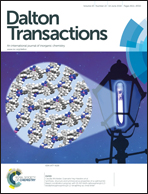Folates are potential ligands for ruthenium compounds in vivo†
Abstract
Under physiologically relevant conditions, cis-bis(2,2′-bipyridine)dichlororuthenium(II), [cis-Ru(2,2′-bipy)2Cl2] was observed to bind to folic acid via replacement of the two chloride ligands. This binding was shown to be pH dependent and afforded diastereomers, the structures of which were determined by 1- and 2D NMR spectroscopic techniques. We propose that when studying the cytotoxicity of labile ruthenium complexes in cells, folate coordination should be considered.


 Please wait while we load your content...
Please wait while we load your content...